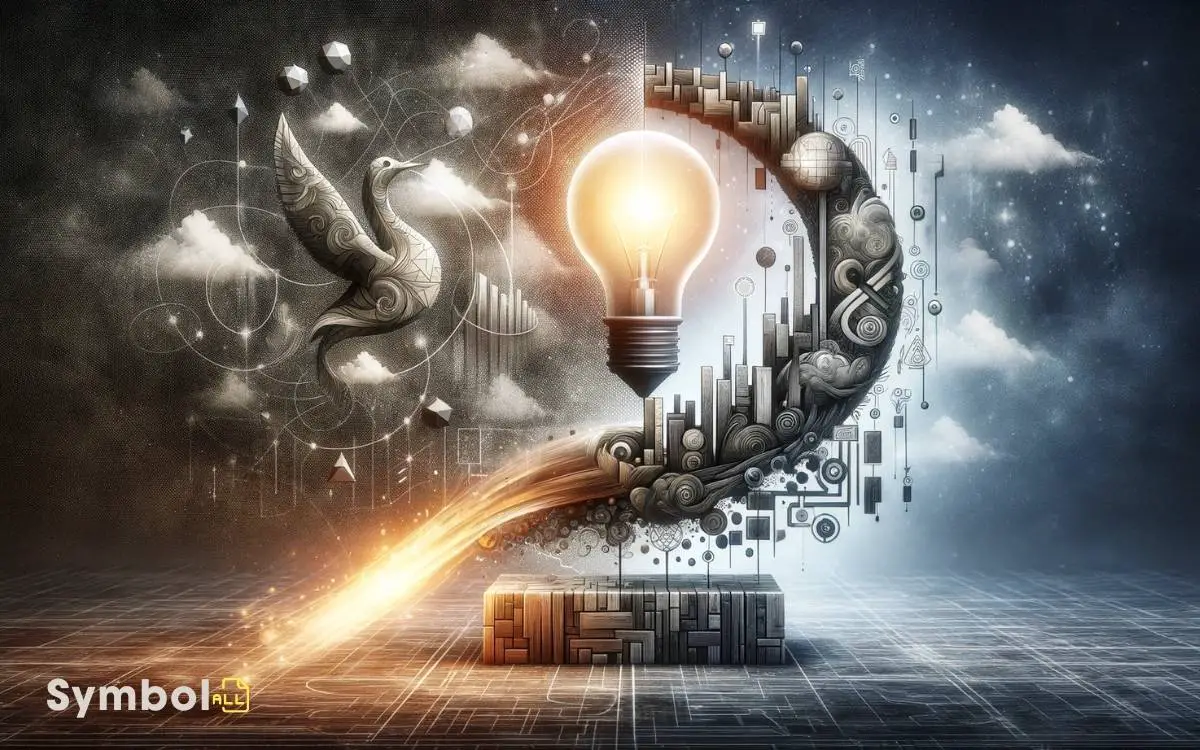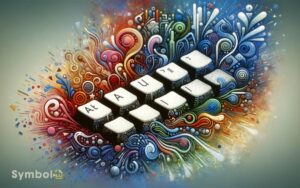Symbolism Uses a Concrete Image to Convey Something That Is?
Symbolism lets you see beyond the surface, offering a bridge between the tangible and intangible. Through symbols, you grasp complex ideas, feeling the pulse of narratives that resonate deeply.
They transform ordinary objects into vessels filled with profound meanings, connecting you to the artist’s or author’s core message. It’s an art form that blooms across cultures, evolving with society’s shifting values.
Each symbol, from nature’s trees to the endless hues of colors, holds keys to unlocking human emotions and life’s mysteries.
Understanding symbolism opens a world where concrete images reveal hidden layers, inviting you to explore further and uncover the rich tapestry of meanings woven into our world. Through this lens, everyday objects transform into vessels of deeper significance, carrying messages that resonate beyond their immediate appearance. Using symbolism in sentences allows writers to communicate complex ideas and emotions subtly, creating a profound impact on their audience. By interpreting these symbols, readers engage in a dynamic interaction with the text, uncovering insights that transcend the surface narrative.

Key Takeaways
The Essence of Symbolism
Symbolism serves as a bridge, connecting the tangible world to deeper, often hidden, layers of meaning. When you encounter a symbol, it’s not just the object you’re seeing; you’re glimpsing a vast, interconnected web of significance that transcends the literal.
Think of how a simple rose isn’t merely a flower but can express love, secrecy, or even the passage of time depending on its context.
This transformative power of symbols lets you communicate complex ideas and emotions succinctly, weaving narratives that resonate on multiple levels.
Historical Context
You’ll find that tracing symbolism back to its ancient roots reveals a rich tapestry of meaning that has evolved dramatically over centuries.
As you explore the transition from medieval to modern interpretations, it becomes clear that each era’s societal values and beliefs significantly influenced the shift in symbolic meanings.
This historical journey not only deepens our understanding of symbols but also reflects the changing human psyche across time.
Ancient Symbolism Origins
Why did ancient civilizations embed such profound meaning in their symbols, and how does this practice inform our understanding of their cultures?
You see, these early societies weren’t just creating art; they were encoding their worldview, beliefs, and values into tangible forms.
This act of embedding symbolism into objects, architecture, and texts offered a durable way to communicate and preserve their identity across generations.
For you, as someone keen on understanding, deciphering these symbols opens a window into the minds and hearts of ancient peoples.
It reveals their relationship with the divine, nature, and each other.
Medieval Symbolism Evolution
As we transition into the medieval period, it’s crucial to recognize how societal and religious upheavals shaped the evolution of symbolism, deeply intertwining it with the fabric of daily life and spirituality.
This era, marked by the rise of Christianity across Europe, saw symbols becoming vessels of profound religious meanings. The cross, for instance, evolved beyond a mere object, embodying sacrifice, redemption, and the eternal.
Similarly, animals like the lion symbolized courage and Christ’s resurrection, while the lamb represented innocence and Jesus himself.
These symbols weren’t just decorative; they were educational tools in a largely illiterate society, conveying complex theological ideas through visual means.
Thus, medieval symbolism served as a bridge between the divine and the mundane, enriching the spiritual life of the common folk.
Modern Interpretations Shift
Moving forward into the modern era, it’s evident how shifts in societal values and technological advancements have dramatically altered the interpretation of symbols, reflecting a broader range of meanings beyond their medieval origins.
You see a dynamic transformation, where:
- The cross, once primarily a religious icon, now also symbolizes hope and healing in secular contexts.
- The lion, a medieval emblem of royalty and bravery, has evolved to represent leadership in corporate branding.
- The rose, traditionally linked to romance and secrecy, increasingly signifies political resistance and social movements.
- Digital icons, such as the heart and thumbs-up, have emerged, transcending language barriers to convey universal emotions.
This evolution underscores the fluid nature of symbolism, where meanings expand and adapt, mirroring the complexity of modern society.
Visual Symbols in Art
Throughout history, artists have employed visual symbols in their work to convey deeper meanings and evoke complex emotions in the viewer. You’ve likely encountered artworks that, at first glance, seem straightforward but hold layers of significance upon closer examination.
| Symbol | Possible Meaning |
|---|---|
| Skull | Mortality, contemplation |
| Dove | Peace, purity |
| Broken Chain | Freedom, liberation |
These symbols serve as bridges between the seen and the unseen, guiding you towards a more profound understanding. For instance, a skull in a painting isn’t just a reminder of death but invites you to contemplate life’s transient nature.
Similarly, a dove isn’t merely a bird but a beacon of hope and renewal. By deciphering these symbols, you engage in a dialogue that transcends time, connecting with the artist’s core message.
Literary Symbolism
Just like in visual arts, literature is rich with symbols that authors use to add depth and layers of meaning to their narratives, inviting you to uncover the treasures hidden within the text.
Through symbolism, you’re transported beyond the surface of the story into a realm where every element potentially harbors a deeper significance.
Consider these examples:
- The green light in The Great Gatsby symbolizes Gatsby’s unattainable dreams.
- The white whale in Moby-Dick represents the elusive nature of truth.
- The road in On the Road serves as a metaphor for life’s journey.
- The mockingbird in To Kill a Mockingbird symbolizes innocence harmed by evil.
These symbols transform the narrative, offering you insights into characters’ motivations, themes, and the human condition, enriching your experience and understanding of the literary work.
Cultural Significance
As you explore the cultural significance of symbolism in concrete images, you’ll uncover the historical roots that anchor these symbols in their original contexts.
You’ll see how their meanings evolve over time, reflecting shifts in societal values and norms.
Comparing global interpretations reveals a rich tapestry of cultural dialogue and exchange, highlighting the fluidity and complexity of symbolic language across cultures.
Historical Roots Explored
Delving into the historical roots of symbolism in concrete images reveals how cultural significance has evolved, shaping our understanding of visual narratives.
Symbolism isn’t just a modern artistic choice; it’s a tradition that stretches back through the annals of history, evolving alongside society’s values and beliefs.
To grasp its depth, consider:
- Ancient cave paintings where animals and handprints weren’t mere depictions but held spiritual meanings.
- Egyptian hieroglyphs, where symbols bridged the divine and the mortal.
- Medieval heraldry, encoding family lineage and honor into intricate designs.
- Renaissance art, where everyday objects in paintings hinted at deeper, often religious, themes.
These instances show you how symbolism served as a mirror to the world, reflecting societal changes, beliefs, and values across eras.
Evolving Symbolic Meanings
Understanding the historical roots of symbolism allows us to appreciate how its meanings have transformed, reflecting shifts in cultural significance over time.
These changes aren’t arbitrary but deeply intertwined with societal evolution, technological advancements, and changing worldviews.
You’ll see that symbols once anchored in specific cultural contexts now possess layers of meaning, adapting over centuries or even decades.
| Symbol | Evolved Meaning |
|---|---|
| Dove | From purely religious peace symbols to broader representations of hope and reconciliation. |
| Skull | Once a stark reminder of death, now also embraced in fashion and art as a symbol of change or rebellion. |
| Rose | Its significance has bloomed from love and secrecy to encompassing broader themes of beauty and fragility in life. |
| Lion | Beyond strength and royalty, it symbolizes courage and protection in modern narratives. |
| Tree | Initially rooted in life and fertility, now also symbolizing environmental conservation and interconnectedness. |
This evolution showcases the dynamic nature of symbols, mirroring the fluidity of human culture itself.
Global Interpretations Compared
Exploring the cultural significance of symbols reveals how they carry varying messages across the globe, reflecting diverse traditions and perspectives.
Consider the following:
- The Lotus Flower: In Eastern traditions, it symbolizes purity and enlightenment, rising immaculately from muddy waters. In contrast, Western interpretations may view it merely as an exotic beauty, often detached from its spiritual significance.
- The Eagle: Seen as a symbol of freedom and strength in the United States, the eagle holds different connotations in other cultures, such as spiritual protection and divine connection among Indigenous peoples.
- The Color Red: In China, it’s a harbinger of luck and joy, whereas in some Western contexts, it can signal danger or passion.
- The Cross: Predominantly a symbol of salvation and faith in Christianity, its interpretation can vary significantly outside this context, sometimes seen as a historical or cultural artifact rather than a religious emblem.
This juxtaposition underscores the rich tapestry of human culture and the importance of context in unraveling the layers of meaning behind symbols.
Nature as Symbol
Nature often serves as a powerful symbol in literature, reflecting complex human emotions and universal themes. When you delve into texts, you’ll find that a simple flower isn’t just a flower; it’s a mirror to the soul, representing love, loss, or rebirth.
Trees, with their deep roots and sprawling branches, often stand for life’s interconnectedness or individual growth.
Consider the ocean’s dual nature; it’s both a life-giving force and an unfathomable abyss, symbolizing the depths of human subconscious or the vastness of emotional experiences.
Through these natural elements, authors convey messages that resonate on a deeper level, offering you insights into the human condition. Nature’s symbols are a bridge, connecting you to the intricate web of life and its myriad experiences.
Color Meanings
Colors weave a complex tapestry in literature, each hue imbuing a narrative with profound symbolic meanings that resonate with your emotions and experiences.
When you encounter colors in a text, they’re not just decorative; they’re deeply symbolic, offering insights into themes, characters, and moods.
Consider how these colors might paint pictures in your mind:
- Red often signals passion, danger, or power, evoking strong emotions.
- Blue can represent calmness, sadness, or wisdom, inviting introspection.
- Yellow might suggest joy, energy, or sometimes deceit, depending on its context.
- Green frequently symbolizes nature, growth, or envy, drawing connections to the environment and human emotions.
Analyzing these colors allows you to uncover layers of meaning in a narrative, enriching your understanding of the text.
Archetypal Symbols
Delving deeper into the realm of literature, you’ll find that archetypal symbols serve as universal touchstones, connecting readers across different cultures and time periods through shared human experiences.
| Archetype | Meaning |
|---|---|
| Water | Represents life, purification, and renewal. |
| Circle | Symbolizes wholeness, unity, and eternity. |
| Light vs. Dark | Embodies the contrast between knowledge and ignorance, good and evil. |
| The Quest | Represents a journey towards self-discovery or a higher understanding. |
| The Hero | Embodies courage, sacrifice, and the potential for greatness within us all. |
These symbols dive deep into our collective unconscious, offering a rich layer of meaning that transcends the literal.
As you explore literature, you’ll discover that these archetypal symbols not only enrich the narrative but also resonate on a deeply personal level, inviting you to reflect on your own journey and the universal truths that bind us all.
Symbolism in Cinema
In cinema, you’ll find that iconic objects often carry weight beyond their physical presence, embodying themes or character journeys.
The use of color in scenes isn’t just for aesthetics; it’s a psychological tool that subtly influences your emotions and understanding of the narrative.
Similarly, character archetypes and symbols enrich storytelling, offering layers of meaning that invite you to look beyond the surface.
Iconic Objects in Films
Iconic objects in films often serve as visual metaphors, enriching the narrative by adding layers of meaning that resonate with viewers on a subconscious level.
- The Ruby Slippers in The Wizard of Oz symbolize the power and autonomy Dorothy seeks, illustrating that what she desires is within her all along.
- The Chess Set in The Seventh Seal represents the intellectual and moral game between life and death, highlighting the strategic moves we make in the face of our mortality.
- The Wilson Volleyball in Cast Away embodies human connection and sanity, showcasing the depths of isolation and the innate need for companionship.
- The Rosebud Sled in Citizen Kane serves as a poignant reminder of lost innocence and the simplicity of happiness, contrasting sharply with the complexity and emptiness of wealth.
These objects invite you to delve deeper, encouraging a more engaged and thoughtful viewing experience.
Color Psychology in Scenes
Exploring the rich tapestry of color psychology in cinema reveals how filmmakers strategically use hues to evoke emotions, hint at character traits, and foreshadow events, offering a deeper understanding of the narrative’s undercurrents.
You’ll notice that red often symbolizes passion or danger, tapping into your visceral responses. Blue, on the other hand, might calm you, suggesting tranquility or sadness.
Directors and cinematographers carefully select color palettes to subconsciously communicate with you, guiding your emotional journey through the story.
For instance, a scene bathed in green might indicate jealousy or sickness, engaging your senses to perceive thematic elements beyond dialogue and action.
This deliberate choice enriches your viewing experience, making you an active participant in unraveling the film’s deeper meanings.
Character Archetypes and Symbols
Delving into the realm of cinema, you’ll uncover how character archetypes and symbols serve as the backbone of storytelling, guiding audiences through complex narratives with universally recognizable cues.
These elements aren’t just characters on a screen; they’re signposts, directing your emotions and thoughts in subtle yet powerful ways.
Consider:
- The Hero: Often embodies courage and morality, drawing you into their journey.
- The Mentor: Provides wisdom and guidance, symbolizing knowledge and growth.
- The Shadow: Represents the antagonist, mirroring dark traits or challenges the hero must overcome.
- The Threshold Guardian: Stands as obstacles or tests, symbolizing the hero’s challenges on their journey.
Each archetype and symbol crafts a rich, immersive experience, making you not just a viewer but a participant in the unfolding drama.
Interpreting Symbolism
Often, interpreting symbolism in concrete images requires you to look beyond the surface, uncovering layers of meaning that resonate with personal and collective experiences.
Delving into the symbolism of an image isn’t just about recognizing what’s presented; it’s about connecting the dots between what you see and what it signifies on a deeper level.
| Symbol | Common Interpretation | Personal Interpretation |
|---|---|---|
| Water | Life, purity, renewal | Emotional cleansing |
| Light | Hope, guidance, truth | Enlightenment |
| Tree | Growth, nature, life | Personal development |
| Bird | Freedom, peace | Liberation from confines |
Interpreting symbols requires you to engage with the image, asking yourself what it stirs within you. It’s a process that blends intuition with knowledge, where understanding blooms from both what is universally acknowledged and what is intimately felt.
Conclusion
Embarking on a journey through symbolism is like wandering through Alice’s Wonderland, where every object, color, and shadow whispers secrets of the universe.
You’ve glimpsed the depths where symbols serve as bridges between the tangible and the intangible, painting our world with layers of meaning only the heart can interpret.
As you decipher these cryptic messages, remember, like Da Vinci’s enigmatic Mona Lisa, the true essence of symbolism lies in its ability to evoke questions rather than provide answers.
Embrace this quest for understanding, for in the realm of symbols, you’re both the seeker and the sage.






